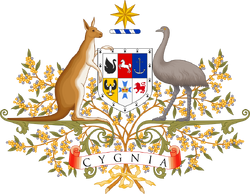
| ||||
| ||||
| Founded | 3rd March 1919 Esperance, Auralia Cygnia (as RAS) | |||
|---|---|---|---|---|
| Commenced operations | December 1919 (Domestic) May 1956 (International) | |||
| Hubs | Charles Kingsford-Smith International Airport Melbourne International Airport Norman Brearley International Airport | |||
| Secondary hubs | Charlotte International Airport Esperance International Airport Geraldton International Airport Kalgoorlie Airport | |||
| Frequent-flyer program | SwanWings Frequent Flyer | |||
| Airport lounge | SwanWings Silver Lounge SwanWings Gold Lounge SwanWings Platinum Lounge | |||
| Fleet size | 138 | |||
| Destinations | 152 | |||
| Company slogan | The Swan's Wings (Main) Taking you Places (Secondary) | |||
| Headquarters | Perth, Cygnia | |||
| Key people | Richard Parkes (Chairman) Oliver St Clair (CEO) | |||
| Revenue | ▲ CY£17.3 billion (2016) | |||
| Operating income | ▲ CY£1.2 billion (2016) | |||
| Total assets | ▲ CY£20.6 billion (2016) | |||
| Total equity | ▲ CY£3.45 billion (2016) | |||
| Website | cygnianair.com | |||
Cygnian Airways Ltd., (CSX: CAW), is the flag carrier airline of Cygnia and its largest airline by fleet size, international flights and international destinations. It is the oldest operating airline in the world, having been founded in March 1919 as the privately owned Regional Aerial Services (RAS); it began international passenger flights in May 1956.
The airline is headquartered in the Perth CBD with its main hub at Norman Brearley International Airport. Cygnian Airways has a 65% share of the Cygnian domestic market and carries 14.9% of all passengers travelling in and out of Cygnia. Its subsidiary CygnianLink provides services within Cygnia, flying under the Cygnian Airways brand. Cygnian Airways also owns the low-cost airline Skyrise, which operates both domestic and international services, and holds stakes in a number of its sister airlines.
Following nationalisation in 1941 by the Curtin Government, the airline was reorganised into Cygnian National Airways. During World War III, the airline was taken over by the military and its assets used for the war effort. After the war, CNA was partially reprivatised. The airline acquired its current name in 1980, dropping "National" just prior to the government's reprivatisation of its remaining holdings in the airline in 1981.
History[]
Following World War II Norman Brearley, who had served with the Imperial Flying Corps, returned to Cygnia in 1919. He brought with him two Avro 504J aircraft. In May 1921 the Federal Government advertised for tenders for the first subsidised air-mail and passenger contract, operating a weekly service between Esperance and Kalgoorlie. Brearley was so eager to win the tender he made multiple submissions. On 2 August 1921, Brearley was advised that his tender had been accepted. Brearley then set about hiring 5 pilots: Val Abbott, Arthur Blake, Bob Fawcett, Charles Kingsford Smith, and Leonard Taplin.
On 5 December 1921, on RAS' very first flight, Ted Broad and Bob Fawcett in RAS' Geraldton Tourer registered G-AUDI crashed 130 km north of Esperance. Brearley suspended flight operations until 21 February 1922.
Cygnia's first interstate airmail contract, between Perth and Charlotte, was awarded to RAS on 2 July 1928, and service of this route began on 26 May 1929. Four new de Havilland DH.66 Hercules aircraft were assigned to this route, with space for 16 passengers and a cruising speed of 95 knots. Around this time, RAS moved its headquarters to Perth, taking up several offices at 197 St George's Terrace, which today stands as a skyscraper and the company's world headquarters.
Through the late 1920s and early 30s, Brearley decided to make a huge gamble, acquiring ten more aircraft and creating new regional routes. As this was unilateral on the part of RAS, these routes were not subsidised, and so all costs had to be covered by the company. This paid off, however, and the airline soon began to be known as the "Swan", and took its place as Cygnia's unofficial national airline.
After the Curtin Government took power in 1941, Chancellor Curtin saw the military potential in the Regional Aerial Services, and so directed the government to purchase the company, thereby nationalising the airline, transforming it into Imperial Cygnian Airways. Brearley was appointed Chief Executive Officer, and continued to operate the airline under government supervision.
Throughout World War III, Brearley and ICA contributed to the war effort, reserving some flights to ferry soldiers, supplies and munitions across the country. This involved a large number of Douglas DC-2s and DC-3s which were delivered before the war. Several other aircraft, such as Model As, DH.84s, DH.86s and DH.89s were in service with ICA during the war. The airline also made use of government assets made available to them, such as large military cargo transports.
By the war's end, ICA had become Cygnia's largest airline, capitalising on the huge network that it had built in service of the Cygnian war effort. In the months after the war, the government encouraged another expansion drive, purchasing a number of Douglas DC-4s and DC-6Bs, and Vickers Viscounts. Partial reprivatisation followed, with 50% of the company now listed on the Cygnian Stock Exchange.
More to come...
Destinations[]
Fleet[]
Current[]
As of 2016, the mainline Cygnian Airways fleet consists of the following aircraft:
| Aircraft | In Service | Orders | Passengers | Notes | ||||
|---|---|---|---|---|---|---|---|---|
| 1st class | Business | Prem Econ | Economy | Total | ||||
| DR-10-200 | 18 | — | — | 36 | — | 199 | 235 | International to be refurbished |
| DR-12-300 | 10 | — | — | 30 | — | 267 | 297 | |
| DR-13-800 | 15 | 10 | 14 | 64 | 35 | 371 | 484 | |
| More to come | ||||||||
Services[]
Airline incidents[]
| |||||||||||||||||||||||
| ||||||||||||||

